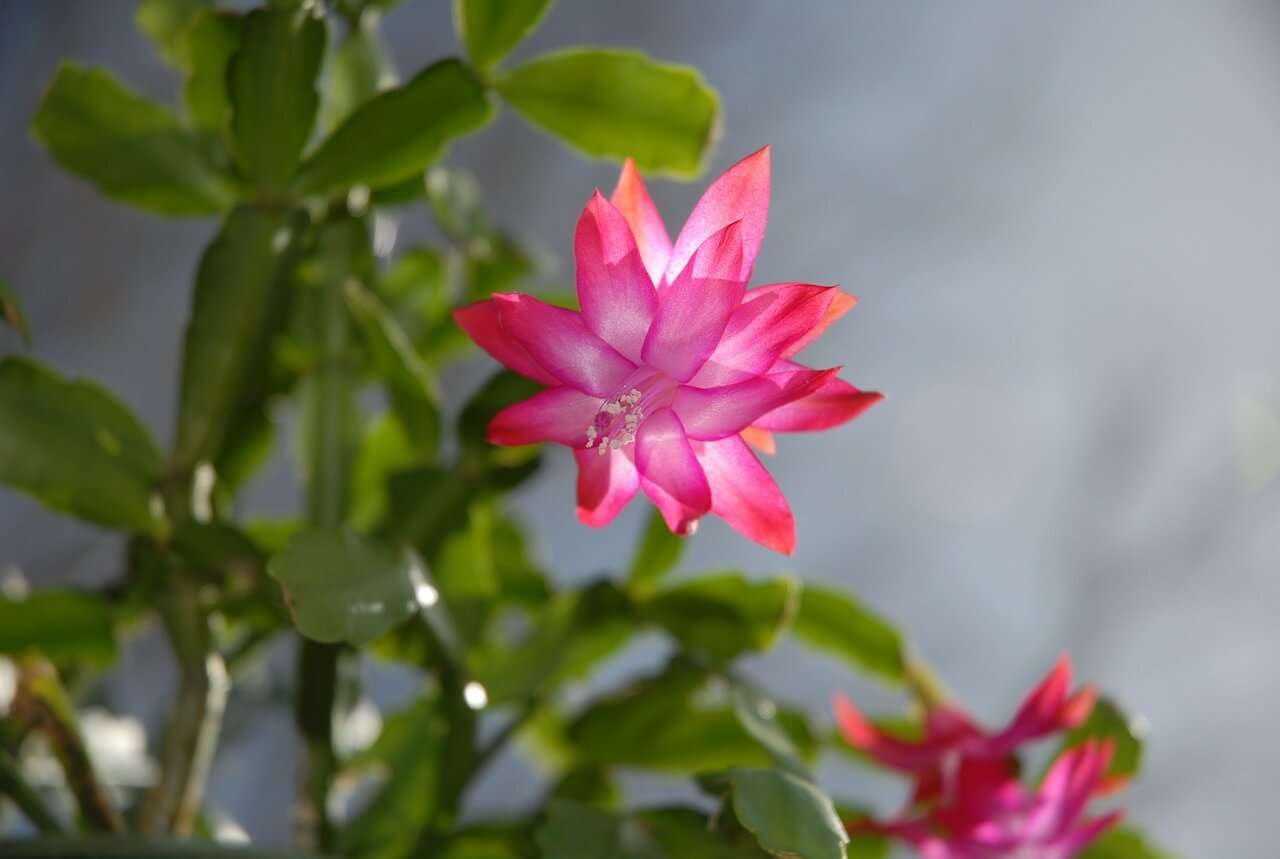Understanding the Christmas cactus
The Christmas cactus is native to Brazil. It loves indirect sunlight and moist soil. Its broad, flat leaves grow in alternate patterns. Its flowers bloom from the tips of its stems. To take care of this special plant, know its growth patterns and environment.
Protect your Christmas cactus from direct sunlight. Water when the soil begins to dry out. This plant usually blooms during wintertime. But, with care, it flowers all year. Too much or too little water will make the foliage droop.
Caring for a Christmas cactus involves observing its blooming patterns. Control light levels and temperature in fall. This sudden change can trigger flowers.
Repot your cactus every few years in fresh soil. Don’t over-fertilize, as it can damage its root system. With proper care, Christmas cacti can live for decades. Give it TLC – even prickly plants deserve spa treatment!
Providing optimal growing conditions
To provide optimal growing conditions for your Christmas cactus, you need to take care of its needs through different means. Choose the right soil, maintain appropriate temperature and lighting, and provide adequate water and humidity to ensure that your cactus thrives and blooms beautifully.
Choosing the right soil
Choosing the right foundation for planting is vital for optimal results. Soil gives roots, nutrients, water and microorganisms a base to work together and grow strong plants.
| Soil Type | Description | Purpose |
|---|---|---|
| Sandy Soil | Coarse; Fast draining; Low fertility | Suited for drought-tolerant crops; Poor for crops needing moisture retention. |
| Clay Soil | Dense; Poor drainage; High water retention; Rich in Nutrients | Perfect for water-loving plants, like Rice; Not suitable for root vegetables due to poor permeability. |
| Loam Soil | Mix of sand, silt, clay; Equal air & water-holding capacity. | Ideal choice for most plants. |
Plus, factors such as ph level, organic material content and area climate should be taken into account when assessing soil appropriateness. Throughout the ages, different soil types have been valued as precious resources since cultures relied on agriculture. Ancient civilizations like Egypt and Mesopotamia thought divine powers managed the land’s fertility. They created sacred rituals during the dry season when the Nile river withdrew from flooding.
Growing plants is like being a bad parent. Neglect temperature and lighting and they’ll never reach their full potential.
Maintaining appropriate temperature and lighting
Maintaining ideal conditions for plants is must-have for lush and healthy growth. Temperature and lighting are key elements in providing these conditions.
| Temperature | Lighting |
| Plants need day temps between 60-75°F and night temps between 55-65°F. | Plant type determines light needs; some need direct sunlight, others partial or full shade. |
| Thermostat and/or heating/cooling system may be needed. | Indoors, artificial lights may be necessary if natural light isn’t enough. |
Ventilation to regulate temp, reflective materials to maximize natural light, and shading during peak sun hours are also important.
Since ancient times, temperature and lighting have been essential for successful crops. Early farmers used various techniques to manipulate both. The Romans even used greenhouses – proof that controlling growing conditions has always been important.
Plants need water and humidity like a toddler needs a splash park. Floaties are optional!
Providing adequate water and humidity
For optimal growing conditions, water and humidity control is essential. Factors such as soil type, weather, plant species, and location should be taken into account.
Understand the requirements of your plants. Too much water can cause root rot and not enough can leave plants wilting or cause stunted growth. Maintain humidity levels to prevent fungal growth, diseases, and pests.
Airflow is also important. Poor ventilation between plants or in confined areas can slow growth.
Invest in systems that regulate watering schedules and humidity levels. Drip hoses or misters also provide controlled water supply and humidity.
To get the best results, monitor water and humidity levels. This way, you can maximize crop quality! Don’t let your plants OD on Miracle-Gro!
Proper fertilization
To ensure your Christmas cactus thrives during the growing season, proper fertilization with the right type of fertilizer and frequency is essential. Using the wrong fertilizer or fertilizing too often can do more harm than good. In this section, we will explore the sub-sections of using the right type of fertilizer and frequency of fertilization.
Using the right type of fertilizer
Choosing the right fertilizer for your plants is key to their growth and health. Consider your plants’ needs and the soil type and climate before picking one. Organic fertilizers are eco-friendly and offer long-term benefits.
Be careful with amounts: too much or too little can have negative effects. Picking the ideal fertilizer will provide essential nutrients and boost growth.
The Tampa Bay disaster of 1948 showed the need for proper fertilization. Too much chemical use in water resources can harm plants and aquatic ecosystems. Who needs a multivitamin when you can just fertilize your plants?
Frequency of fertilization
The timing of supplying nutrients to plants is known as ‘Optimal Frequency of Fertilization.’ Factors such as plant species, soil quality and nutrient requirements determine it. Consistent supply of nutrients is essential for optimum growth.
| Plant Type | Fertilization frequency |
|---|---|
| Turfgrass | 4-6x annually |
| Garden Flowers | Every 2 wks in spring/summer |
| Vegetables | Every 3 wks in spring/summer |
Over-fertilizing can harm plants and pollute water sources. Hence, be sure to follow the manufacturer’s fertilizer application rate instructions.
Pro Tip: Test soil regularly for nutrient composition. This will help you adjust fertilizer schedule and enjoy fresh green foliage and beautiful flowers.
Look after your plants just as you do your relationships – with constant attention and occasional pruning.
Maintenance and pruning
To maintain and prune your Christmas cactus properly, you need to be equipped with the right knowledge. One of the essential steps is to remove spent flowers and damaged leaves effectively. Additionally, it’s equally important to maintain the plant’s shape and size.
Removing spent flowers and damaged leaves
In order to keep your plants healthy, it’s vital to get rid of dead or damaged parts regularly. This involves cutting off spent flowers and damaged leaves in the correct way. Here’s a six-step guide on how:
- Check your plant to spot any dead or damaged parts.
- Use garden shears or scissors to snip off spent flowers as close to the base as you can.
- Pinch off leaves that are just starting to yellow near the stem.
- If leaves are badly damaged, use pruning shears to cut them at the base without damaging healthy sections.
- Put all removed material in a compost bin or trash can.
- Monitor your plants often and repeat the process as needed.
It’s worth noting that not all plants need regular removal of spent flowers and damaged leaves – some species actually benefit from leaving them on for a while.
Pro Tip: Some gardeners like to remove only the flowers, not entire stems, so the plants can bloom again. So, give your plants a trim – they’ll thank you with a neat and tidy look!
Maintaining shape and size
Pruning and upkeep is key to getting plants to stay in the desired form and size. Trimming ensures plants grow healthily. Dead branches, infected branches, and crossing limbs must be removed to prevent diseases.
Otherwise, plants can become unruly. This messiness affects the beauty of a garden or landscape. Pruning trains plants for optimal sun exposure, leading to better growth.
It also improves air flow within the plant, making the roots stronger and providing protection from bad weather. Pruning fruit trees helps increase crop yield by eliminating unhealthy limbs.
Farmer’s Almanac states that proper pruning can extend the life of different plant species. Pruning is like fixing a problem – you have to cut out the deadwood to make room for new growth.
Common problems and solutions
To care for a healthy Christmas cactus, you need to address common problems such as overwatering and drying out, as well as pests and diseases. That’s why, in this section on common problems and solutions, we’ll introduce you to two sub-sections – overwatering and drying out, and pests and diseases – which can help you maintain the health of your Christmas cactus.
Overwatering and drying out
Plant care can be tricky, as overwatering and dehydration are common issues. They may be caused by temperate, humidity, light, soil type, pot size, and drainage system. To avoid overwatering, it’s important to learn each plant’s needs. Wind exposure, location, and age also influence hydration levels. Monitor plants and adjust accordingly.
One gardener learned the hard way: despite being told otherwise, they watered their succulent garden every day – ultimately killing all plants due to root rot. It’s essential to understand individual plants’ needs rather than generalizing care. Who needs a guard dog when you have a garden full of pests to protect your home?
Pests and diseases
Identify the pest nematodes and fungi to distinguish them from helpful soil organisms. Control pests through crop rotation, removing infested plants, using biological control agents, and planting pest-resistant seeds. Lower humidity levels to prevent diseases with air flow, irrigation, and proper plant spacing. Monitor soil pH to avoid nutrient deficiencies that make plants prone to diseases. Regularly inspect for symptoms of sickness as a preventive measure.
Take action against plant invasions to get higher yields. Don’t let diseases or infestations reduce profitability. Utilize preventive measures to protect your investment and choose plants that are better suited for sustainable farming. Why buy a Christmas cactus if you can just steal a cutting from your neighbor and propagate it like a Grinch?
Propagating the Christmas cactus
To propagate your Christmas cactus successfully, you need to know the right techniques. In order to achieve that, this section on propagating the Christmas cactus with stem cuttings propagation and division propagation will provide you with solutions to grow healthy new plants.
Stem cuttings propagation
Growers can propagate new Christmas cactus plants by taking stem cuttings of 3-4 segments in length. These should be cut directly above or below a leaf segment, and left to dry for up to two weeks – allowing the cutting to develop a callus.
A step-by-step guide for successful propagation:
- Pick a healthy cactus
- Find a suitable stem
- Cut the stem near the base
- Place the section into moist soil and provide it with enough sunlight
- Maintain appropriate moisture levels until the new plant takes root.
Roots can form from contact with either soil or water. Yet, water propagation may increase the risk of disease transmission, so we recommend growing them in soil.
During winter, an amateur gardener was thrilled to discover that he could propagate new tiny Christmas cactus plants from cuttings! After carefully pruning each stem and patiently waiting for the growth of tiny roots, he was delighted with the results! Sharing is caring, even during the holidays – so go ahead and divide your Christmas cactus!
Division propagation
Division propagation is a way to increase the number of Christmas cacti in one’s garden. It involves gently separating a mature plant into three to four sections and replanting them. Though successful, it can harm the original specimen if not done right. Newly separated plants require careful watering and attention.
This technique has been around for centuries. But, with new tech like cloning and hybridization, it’s less popular now. Late spring or summer is the best time to do it.
Frequently Asked Questions
1. How often should I water my Christmas cactus?
A: Christmas cacti do not require a lot of water. Water it when the top inch of soil is dry to the touch. In general, once a week is sufficient.
2. How much light does a Christmas cactus need?
A: Christmas cacti prefer bright, indirect sunlight. They can also tolerate some shade. Avoid direct sunlight as it can scorch the leaves.
3. How do I fertilize my Christmas cactus?
A: Use a balanced, water-soluble fertilizer every two to three weeks during the growing season (spring and summer). Do not fertilize in fall or winter as the cactus enters a dormant period.
4. Why are the leaves on my Christmas cactus turning yellow?
A: Yellow leaves can indicate overwatering or underwatering, too little light, or stress from a change in location. Assess your watering schedule and move it to a brighter location if necessary.
5. How can I encourage my Christmas cactus to bloom?
A: Christmas cacti bloom in response to cool temperatures and long periods of darkness. To encourage bloom, keep the plant in a room with temperatures between 50-60°F for six to eight weeks prior to the desired bloom time.
6. Can I propagate my Christmas cactus?
A: Yes, Christmas cacti can be propagated by stem cuttings. Take a 2-3 segment cutting and allow it to callus over for a few days before planting in well-draining soil. Keep moist and in a bright location until rooted.




